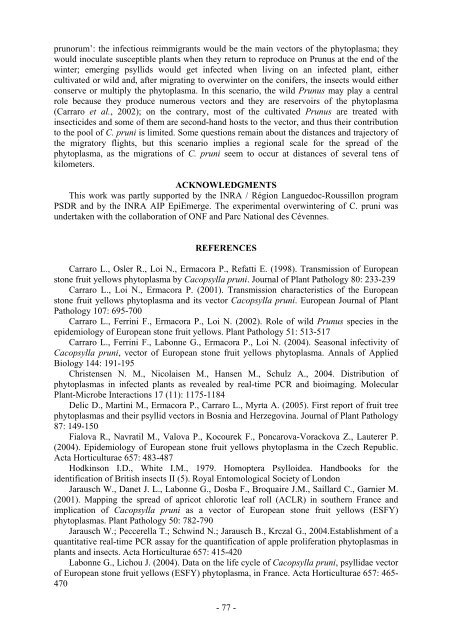Ecole Nationale Supérieure Agronomique de Montpellier ... - CIAM
Ecole Nationale Supérieure Agronomique de Montpellier ... - CIAM
Ecole Nationale Supérieure Agronomique de Montpellier ... - CIAM
Create successful ePaper yourself
Turn your PDF publications into a flip-book with our unique Google optimized e-Paper software.
prunorum’: the infectious reimmigrants would be the main vectors of the phytoplasma; they<br />
would inoculate susceptible plants when they return to reproduce on Prunus at the end of the<br />
winter; emerging psyllids would get infected when living on an infected plant, either<br />
cultivated or wild and, after migrating to overwinter on the conifers, the insects would either<br />
conserve or multiply the phytoplasma. In this scenario, the wild Prunus may play a central<br />
role because they produce numerous vectors and they are reservoirs of the phytoplasma<br />
(Carraro et al., 2002); on the contrary, most of the cultivated Prunus are treated with<br />
insectici<strong>de</strong>s and some of them are second-hand hosts to the vector, and thus their contribution<br />
to the pool of C. pruni is limited. Some questions remain about the distances and trajectory of<br />
the migratory flights, but this scenario implies a regional scale for the spread of the<br />
phytoplasma, as the migrations of C. pruni seem to occur at distances of several tens of<br />
kilometers.<br />
ACKNOWLEDGMENTS<br />
This work was partly supported by the INRA / Région Languedoc-Roussillon program<br />
PSDR and by the INRA AIP EpiEmerge. The experimental overwintering of C. pruni was<br />
un<strong>de</strong>rtaken with the collaboration of ONF and Parc National <strong>de</strong>s Cévennes.<br />
REFERENCES<br />
Carraro L., Osler R., Loi N., Ermacora P., Refatti E. (1998). Transmission of European<br />
stone fruit yellows phytoplasma by Cacopsylla pruni. Journal of Plant Pathology 80: 233-239<br />
Carraro L., Loi N., Ermacora P. (2001). Transmission characteristics of the European<br />
stone fruit yellows phytoplasma and its vector Cacopsylla pruni. European Journal of Plant<br />
Pathology 107: 695-700<br />
Carraro L., Ferrini F., Ermacora P., Loi N. (2002). Role of wild Prunus species in the<br />
epi<strong>de</strong>miology of European stone fruit yellows. Plant Pathology 51: 513-517<br />
Carraro L., Ferrini F., Labonne G., Ermacora P., Loi N. (2004). Seasonal infectivity of<br />
Cacopsylla pruni, vector of European stone fruit yellows phytoplasma. Annals of Applied<br />
Biology 144: 191-195<br />
Christensen N. M., Nicolaisen M., Hansen M., Schulz A., 2004. Distribution of<br />
phytoplasmas in infected plants as revealed by real-time PCR and bioimaging. Molecular<br />
Plant-Microbe Interactions 17 (11): 1175-1184<br />
Delic D., Martini M., Ermacora P., Carraro L., Myrta A. (2005). First report of fruit tree<br />
phytoplasmas and their psyllid vectors in Bosnia and Herzegovina. Journal of Plant Pathology<br />
87: 149-150<br />
Fialova R., Navratil M., Valova P., Kocourek F., Poncarova-Vorackova Z., Lauterer P.<br />
(2004). Epi<strong>de</strong>miology of European stone fruit yellows phytoplasma in the Czech Republic.<br />
Acta Horticulturae 657: 483-487<br />
Hodkinson I.D., White I.M., 1979. Homoptera Psylloi<strong>de</strong>a. Handbooks for the<br />
i<strong>de</strong>ntification of British insects II (5). Royal Entomological Society of London<br />
Jarausch W., Danet J. L., Labonne G., Dosba F., Broquaire J.M., Saillard C., Garnier M.<br />
(2001). Mapping the spread of apricot chlorotic leaf roll (ACLR) in southern France and<br />
implication of Cacopsylla pruni as a vector of European stone fruit yellows (ESFY)<br />
phytoplasmas. Plant Pathology 50: 782-790<br />
Jarausch W.; Peccerella T.; Schwind N.; Jarausch B., Krczal G., 2004.Establishment of a<br />
quantitative real-time PCR assay for the quantification of apple proliferation phytoplasmas in<br />
plants and insects. Acta Horticulturae 657: 415-420<br />
Labonne G., Lichou J. (2004). Data on the life cycle of Cacopsylla pruni, psyllidae vector<br />
of European stone fruit yellows (ESFY) phytoplasma, in France. Acta Horticulturae 657: 465-<br />
470<br />
- 77 -



